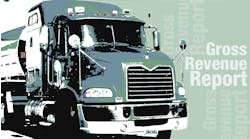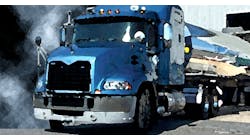Latest from Gross Revenue Reports
TANK TRUCK fleets now have suffered through two of the worst years the industry has ever experienced. Most ominously, total tank truck carrier revenue dropped for the first time since Modern Bulk Transporter began publishing the Annual Gross Revenue Report.
Factors contributing to the overall decline: Total chemical shipments fell 13% between 1999 and 2002. The US economy, which was sluggish through much of 2002, slowed to a crawl late in the year due to pre-war jitters about the Iraq conflict. Fleet overcapacity continues to depress tank truck rates.
Petroleum haulers provided one of the only bright spots in the 2002 Gross Revenue Report. There are indications that these fleet operators have been particularly successful in reducing (or even eliminating) overcapacity. Some data suggests that the overall size of the petroleum sector tank trailer fleet may have fallen by as much as half in the past 10 years. In addition, petroleum carriers have been particularly successful in achieving high levels of operating efficiency from their fleets.
Looking at all tank truck sectors, gross revenues in 2002 fell for about half of the companies participating in this year's report. In addition, about half of the participants reported that operating ratios worsened from 2001 to 2002.
The Top 10 tank truck carriers fared somewhat better than the rest of the industry. Six of them posted higher gross revenues, and all but three improved their operating ratios, even if only slightly.
Among the Top 10, Quality Distribution Inc remained in the lead position. Trimac Transportation Services Inc and The Kenan Advantage Group were two and three respectively. Rounding out the Top 10 were Superior Bulk Logistics Inc, Bulkmatic Transport Co, Schneider National Bulk Carriers (two spots higher than in 2001), Enterprise Transportation Co (new to the Top 10), Groendyke Transport Inc, A&R Transport Inc, and The Dewey Corporation.
The combined Top 10 revenues of $2.1 billion were virtually the same as in 2001 but accounted for 43% of the total revenues in the 2002 report. On a percentage basis, the Top 10 carriers regained ground that was lost between 1999 and 2001. Top 10 revenue is still about $3 billion below the 1999 level.
The top 25 carriers had $3.29 billion in revenues, or 65.2% of the total represented in this report. This was a 2.5% increase over the 2001 report. The 50 largest carriers had revenues of $4.1 billion, accounting for 82.5% of the total, compared with 83% in 2001.
Of the 135 carriers in this report, slightly more than a quarter reported higher revenues in 2002 than in 2001. About 21% were able to improve operating ratios, compared with 24% in 2001.
Total 2002 revenues for all carriers in this report were $5,052,471,196. In 2001, the participating carriers reported a combined total of $5,177,395,128.
For the 135 carriers in this report, the average revenue for 2002 was $37,425,712, down significantly from $41,419,161 in 2001. The median carrier on the list, the one with an equal number of carriers above and below it, had revenues of $15,928,975. In 2001, the median carrier revenue was $17,304,000.
Operating ratios for 2002 and 2001 were supplied by 64 of the carriers in this report. Twenty-six showed improvement over the previous year. The operating ratio represents operating expenses as a percentage of revenue.
Economic difficulties faced by tank truck carriers in 2002 are reflected in the number of operating ratios that were above 95%. Fifty had operating ratios between 95.0% and 99.9%, compared with 45 in 2001. Two carriers posted ratios of 100% or higher, down from four. Ratios between 90.0% and 94.9% were reported by 12 companies, one less than in 2001. Only one carrier had a ratio below 90%.
A majority of carriers in the report supplied tractor revenues, which give an indication of productivity levels. The average for 2002 was $154,966. That was down from the 2001 tractor revenue average of $189,693. Eight of the Top 10 reported tractor revenues, and their average was $152,408.
An East Coast petroleum hauler recorded the highest revenue per tractor, $303,458. The lowest amount ($69,430) came from a southeastern chemical fleet.
Average revenue per tractor for 10 petroleum transporters was $219,486, an increase over the previous year when the same number of fleets achieved a $166,520 average. Petroleum tractor revenues ranged from the high of $303,458 to a low of $96,694.
Ten chemical haulers accounted for average revenue per tractor of $149,434, not far below the overall industry average. The average for chemical haulers in 2001 was $177,118. Tractor revenues ranged from a high of $250,545 down to $69,430.
Average revenue for nine dry bulk carriers was $189,044, significantly above the $151,621 achieved in 2001. Tractor revenues ranged from a high of $295,121 to a low of $118,002.
Among eight carriers specializing in liquid and dry bulk foods, average tractor revenue was $120,413. This was better than the $109,607 average recorded in 2001. The high for the category was $158,771, and the low was $79,117.
Many of the figures here are from preaudited reports, and some may include nonbulk revenues or revenues from subsidiary tank truck carriers. In most cases, the figures were supplied directly to Modern Bulk Transporter. The editorial staff greatly appreciates the cooperation of all who helped in the preparation of this report.
To view a chart with this year's ranking and revenues, use the "Related" link below to find it and all reports going back to 2001 in the Gross Revenue Reports Archive.









